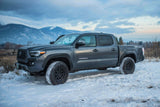Lift kits are a popular upgrade among off-road enthusiasts and truck owners looking to enhance their vehicles' functionality, performance, and look. While many admire the aggressive stance and increased ground clearance they provide, not everyone knows how these kits work. Let’s break down the mechanics behind lift kits, with a focus on the role of rear blocks, U-bolts, and other essential components.
The Core of a Lift Kit: Rear Blocks and U-Bolts
At the heart of many lift kits, particularly for trucks, are rear blocks and U-bolts. These components work together to raise the height of your vehicle’s suspension, providing increased clearance and improved weight distribution.
Rear Blocks: Elevating the Rear Suspension
Rear blocks are solid spacers, often made of steel, aluminum, or cast iron designed to fit between the axle and the leaf spring of your vehicle’s rear suspension system. Their primary function is elevating the vehicle's rear, creating a level or slightly lifted stance.
The science behind rear blocks lies in their ability to change the geometry of the suspension system without altering the leaf springs themselves. Introducing a spacer increases the distance between the axle and the frame, effectively lifting the vehicle. Rear blocks come in various sizes, allowing drivers to customize the lift height to suit their needs.
U-Bolts: Securing the Setup
U-bolts are the unsung heroes of a lift kit. These heavy-duty fasteners hold the rear blocks and leaf springs securely in place. Designed in a U shape, they wrap around the axle and thread through the spring perch, where they are tightened with nuts.
The strength and reliability of U-bolts are critical to the performance of a lift kit. They must endure immense pressure and vibration, especially during off-road adventures. High-quality U-bolts are typically made of hardened steel to resist bending or loosening under stress.
Other Key Components of Lift Kits
Beyond rear blocks and U-bolts, lift kits may include:
- Leaf Spring Add-Ons: Additional or re-arched leaf springs can provide extra lift and support for heavier loads.
- Coil Spring Spacers: Common in front-end lifts, these spacers fit on top of coil springs to increase height.
- Extended Shocks: Longer shocks may be required to maintain proper suspension travel after a lift.
- Control Arms and Track Bars: Essential for larger lifts, these components adjust the vehicle’s alignment to prevent steering or handling issues.
Each of these parts plays a role in ensuring that the lift is not only functional but also safe and durable.
The Benefits of a Lift Kit
Lift kits offer both practical and aesthetic advantages, making them a favorite among vehicle enthusiasts.
- Improved Ground Clearance: Higher suspension means easier navigation over rocks, mud, and uneven terrain.
- Enhanced Towing and Hauling: Rear blocks can help balance the load when towing or carrying heavy cargo.
- Better Visibility: A lifted truck provides a higher vantage point, improving driver awareness on and off the road.
- Customizable Appearance: Lift kits give vehicles a bold, rugged look that turns heads.
Choosing the Right Lift Kit
When considering a lift kit, it’s crucial to match the components to your specific vehicle and driving needs. For light off-roading, a small lift with rear blocks and U-bolts may suffice, while more demanding trails might require a full suspension lift with additional upgrades.





0 comments